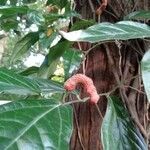Climbers glabrous except for rachis and stigmas, dioecious. Stems brownish when dry, ca. 2 mm thick, terete, striated. Petiole 5-11 mm, sheathed at base only; leaf blade narrowly elliptic, ovate-oblong, or elliptic, 8.5-16 × 3.2-7.5 cm, papery, glaucous when dry, densely glandular, base with both sides rounded or 1 side slightly tapered and short, tapered and short side sometimes concave to semicordate, ± symmetric to oblique, bilateral difference 0-5 mm, apex shortly acuminate to acute; veins 9-11, rarely more, pinnate, usually 4 or 5 on each side of midvein. Spikes leaf-opposed. Male spikes 5-6.5 cm; peduncle slightly longer than petioles; bracts orbicular, 1-1.2 mm wide, peltate, sessile. Stamens 2 or 3; filaments nearly absent; anthers broadly ellipsoid. Female spikes 3-4 cm × ca. 7 mm; peduncle and bracts as in male spikes. Ovary immersed in rachis; stigmas 3, ovate-acute, recurved. Unripe drupe partly connate to rachis, apex rounded. Fl. May-Jul.
More
A climbing shrub. It grows 5-10 m tall. The stem is 3-4 mm across. The leaves are sword shaped and taper to the tip and are unequal at the base. They are 10-12 cm long by 3-4 cm wide. Male and female flowers are on separate plants. Female spikes are 4 cm long while male spikes are 5 cm long. The fruit are oval berries. The spikes are red. Possibly now Piper chaba

